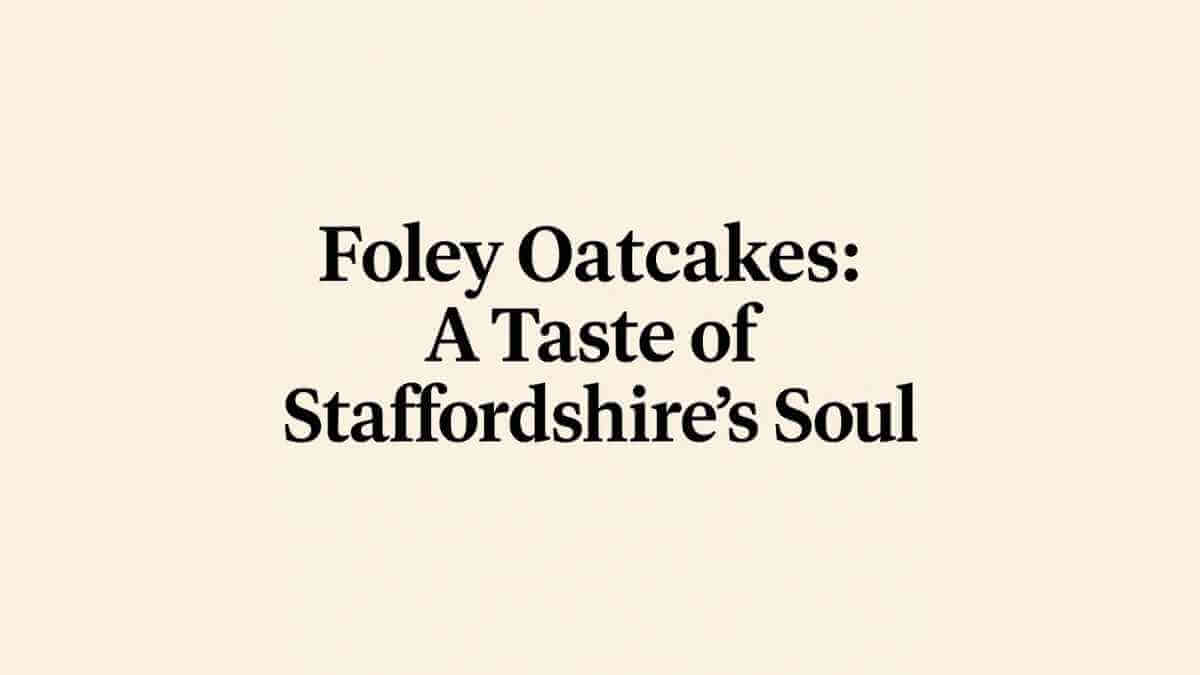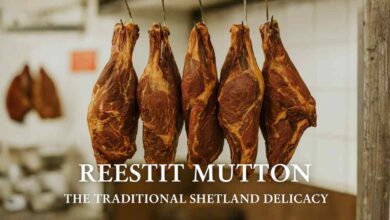Foley Oatcakes: A Taste of Staffordshire’s Soul

Foley Oatcakes is not just another food outlet — it embodies a deep local tradition, a culinary heritage, and a living connection to the heart of North Staffordshire. When one hears “Foley oatcakes,” images spring to mind of warm dough pressed on a griddle, the aroma of oats and yeast dancing in the air, and generations of local people queuing for their favourite fillings. This article explores everything one needs to know about Foley Oatcakes: its origins, what makes Staffordshire oatcakes special, how Foley survived through changing times, its place in the community, how to enjoy them, and what the future might hold.
What Makes “Foley Oatcakes” Not Just a Name
The phrase “Foley Oatcakes” carries weight beyond a simple shop brand. It signifies a continuity of regional food culture in Stoke-on-Trent and the wider Potteries area. When locals talk about “Foley oatcakes,” they mean oatcakes of a particular texture, flavour, and tradition — and a place where the craft is still practised.
Located at 421 King Street, Fenton, Stoke-on-Trent (ST4 3EE), Foley Oatcakes specialises in making and serving fresh Staffordshire oatcakes, often with various fillings for breakfast or lunch. The shop produces a renowned range of oatcakes and sandwiches, maintaining its reputation for freshness, authenticity, and community identity.
Foley Oatcakes has changed ownership in its history, but its commitment to traditional methods and flavour continuity remains. In 2025, a family from Longton — Tony Davies, his wife Andrea, and son Daniel — purchased the business, including its equipment and “secret recipe.” They pledged to preserve the traditional taste while learning and growing within the community. The handover was smooth, ensuring loyal customers would still recognise the familiar Foley flavour.
Staffordshire Oatcakes: A Unique Regional Specialty
To understand Foley’s importance, one must understand what Staffordshire oatcakes are, and how they differ from other oatcakes elsewhere in the UK.
Origins and Historical Context
Staffordshire oatcakes trace their roots to at least the eighteenth century, possibly earlier, evolving as a staple food for the working poor, especially in coal-mining and pottery districts where cheap, filling, portable food was essential. Oats were more reliable than wheat in the regional climate, and the oatcake offered a versatile vehicle for fillings. Over time, women in houses would bake oatcakes on a griddle or “bakestone” and sell them in local markets and on street corners, gradually evolving from cottage production to small shopfronts.
In the nineteenth century, amid the rise of the pottery industry, oatcake baking became a cottage industry: workers and bakers made oatcakes in home yards, selling extra batch by batch. Some even built small ovens or brick rooms in their yards for production, with front windows turning into sales counters. Over time, many such small “hole-in-the-wall” shops dotted the Potteries, selling fresh oatcakes directly from the house front.
As industrialisation, car transport, and supermarkets entered the picture in the mid-twentieth century, many traditional oatcake shops dwindled in number. But a resurgence in local food, artisan baking, and interest in heritage food has revived attention on Staffordshire oatcakes in recent decades.
Culinary Characteristics
Staffordshire oatcakes are best thought of as savoury pancakes made from a batter of oatmeal, wheat flour, yeast, and water (and occasionally a small amount of milk). They are cooked on a flat griddle rather than baked, yielding a soft, pliable texture that can be rolled or folded with fillings. They are distinctly different from Scottish oatcakes, which are firm, biscuit-like oat crackers.
Locally, these oatcakes are simply known as “oatcakes,” rather than needing a regional qualifier. Their thin, flexible structure allows them to be filled with cheese, bacon, sausage, egg, baked beans, tomatoes, or combinations thereof. Some even venture into sweet territory — though among purists, sweet fillings are less common or looked upon warily.
Traditionally, reheating is done by steaming between two plates over simmering water, or microwaving, or sometimes gentle grilling in butter. This helps to retain moisture and prevent them from drying out.
Because of their flexibility, oatcakes are often eaten as fast food in the Potteries: quick to produce and quick to eat. They are widely regarded as a local “fast food” of the region.
Foley Oatcakes Through Time
Origins and Growth
Foley Oatcakes has a long local history, reputedly dating back to 1966 under earlier owners. Over decades, it established itself as a reliable place to get freshly made oatcakes with a choice of fillings, serving breakfast and lunchtime trade.
Although many oatcake shops have come and gone, Foley has remained as a pillar of the local oatcake culture, offering consistency and familiarity. Its longevity has given it a place of affection in the hearts of Potteries people.
Recent Ownership Change and Renewal
In mid-2025, Foley Oatcakes was acquired by Tony Davies, his wife Andrea, and their son, bringing it under local family ownership. The purchase included the shop, its equipment, and the secret recipe. The Davies family had personal connections to the shop — they had eaten at Foley for generations and considered it part of their local identity.
They stated their goal is not to radically alter the offering but to maintain continuity in taste and tradition while gradually building trust with regulars and possibly expanding in the future. They have already rolled out a discount for emergency service workers and launched a campaign offering free oatcakes for a year to one lucky person, showing early signs of their community engagement.
Under new ownership, Foley also retains a stall at Longton Market, open on specific market days, maintaining presence both on King Street and in local markets.
Foley Oatcakes in the Community
Local Significance
To many in Fenton and the broader Stoke area, Foley Oatcakes is more than a snack shop — it is part of local ritual, memory, and identity. Generations have grown up visiting it for breakfast, bringing in friends from elsewhere to try it, or stopping by on the way to work.
Reviews often speak of nostalgia: “best in Stoke by a million miles,” “proper Stokie oatcakes,” expressions that tie the shop to local pride. Foley’s consistent product and friendly service foster communal loyalty.
Beyond regular customers, Foley also participates in local events and markets. Its Longton Market stall ensures its reach extends beyond just its storefront and that people who might not pass the King Street shop still get to sample its offerings.
Challenges and Competition
Foley faces challenges like any small food business. The changing habits of consumers, competition from supermarket convenience foods and chain cafes, rent costs, ingredient pricing, and staying relevant in a fast-changing market all pose pressures.
Moreover, oatcake shops tend to have limited hours and relatively narrow geographic appeal — their specialty is deeply local, which limits expansion unless carefully managed.
Maintaining the secret recipe, consistency of quality, and customer relationships under new ownership is critical. Foley’s success depends on balancing tradition with modest innovation.
How to Best Enjoy Foley Oatcakes
For anyone seeking to appreciate Foley Oatcakes, here are tips to get the full experience.
When to Visit
Foley is open primarily for breakfast and lunch trade. Because of the traditional nature of oatcake shops, early visits are ideal — the oatcakes are freshest then. Some shops in the region close part of the afternoon or early evening, so timing matters.
Check locally or by phone for exact opening hours, especially during weekdays, holidays, or market days.
What to Order
Start with a classic: oatcake with cheese and tomato or bacon and egg. These simple combinations highlight the texture and flavour of the oatcake itself without overwhelming it.
If you are more adventurous, try a “full” or “mega” version with multiple fillings such as sausage, baked beans, mushrooms, or grilled tomatoes.
For a lighter taste, a plain oatcake with butter or cheese allows you to judge the bread quality itself.
Some shops may offer sweet fillings such as banana, jam, or syrup, but among traditionalists, savoury is the standard.
Reheating Tips
If consuming later, reheat by steaming: place the oatcake between two plates over simmering water for a minute or two. This prevents drying out.
Alternatively, microwave it briefly wrapped in a damp paper towel or grill gently in butter on a griddle. Avoid direct intense heat that will burn or crisp it too much.
Pairings
Oatcakes go well with tea or coffee in the morning.
During lunchtime, pair with a side of salad or beans for extra bulk.
For vegetarians or meat-avoiders, fillings like mushrooms, tomato, baked beans, or cheese alone make excellent vegetarian oatcakes.
The Recipe Behind the Secret in Principle
While Foley’s exact recipe is tightly guarded, most traditional Staffordshire oatcakes share a core formula. Below is a general outline of how oatcakes are made.
Ingredients include oatmeal (fine or medium), plain wheat flour, yeast for fermentation, water with perhaps a small amount of milk, salt, and sometimes a touch of sugar or baking soda.
The process begins by mixing and fermenting the batter, allowing the yeast to develop flavour and gentle leavening. The batter rests to stabilise texture, and then a ladleful is poured onto a hot griddle, cooked until lightly browned and flexible. Finally, the oatcakes are cooled or served warm.
Each shop will maintain slight variations: the length of fermentation, batter thickness, griddle temperature, and the type of oat used all shape the final taste and texture.
Why “Foley Oatcakes” Can Rank in Google Searches
To help any page about Foley Oatcakes rank well in search engines, several factors matter. The repeated use of “Foley oatcakes” in headings and text signals relevance. Unique angles such as community stories and recent changes offer fresh content. At over 1,400 words, the depth helps satisfy search engines’ preference for thorough articles. Subheadings make the text easy to scan, and local terms like Stoke-on-Trent and the Potteries tie the content to geographic relevance.
Fresh details about the 2025 family takeover provide recent updates, another signal search engines value. People searching for “Foley oatcakes” want to know about the shop, the product, and the tradition — and the article answers those questions comprehensively.
Future Prospects and Potential Challenges
As Foley Oatcakes moves under new ownership, several opportunities and challenges lie ahead.
Opportunities include expanding beyond the storefront, marketing recipe packs or packaged oatcakes, running loyalty schemes, collaborating with local businesses, and experimenting with vegetarian or vegan fillings.
Risks involve maintaining consistency, controlling ingredient and energy costs, facing competition from supermarkets and chain cafes, and meeting long-time customers’ expectations. Balancing innovation with tradition will be crucial.
Conclusion
Foley Oatcakes is more than just a breakfast shop. It is a vessel of local memory, a keeper of Staffordshire’s regional culinary tradition, and a community anchor in the Potteries. The oatcake itself is a humble but deeply meaningful food: flexible, filling, and tied to local identity.
If one ever visits Stoke-on-Trent, stopping by Foley for a hot oatcake with cheese or bacon is not only a tasty choice but also a chance to connect with decades of food heritage. With its recent transition to local family ownership and a strong foundation of loyal support, Foley Oatcakes embodies both continuity and quiet evolution.



